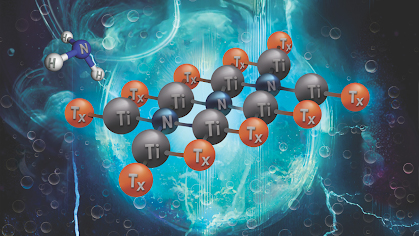
In a hunt for more sustainable technologies, researchers are looking further into enabling two-dimensional materials in renewable energy that could lead to sustainable production of chemicals such as ammonia, which is used in fertilizer.
This next generation of low-dimensional materials, called MXenes, catalyzes the production of air into ammonia for foods and transportation for high-efficiency energy fertilizers.
MXenes has a wide range of possibilities that allow for highly flexible chemical compositions, offering significant control over their properties.
This research is addressed in the Journal of the American Chemical Society in an article by chemical engineering professors Drs. Abdoulaye Djire, Perla Balbuena and Ph.D. candidate Ray Yoo.
Djire and his team are challenging the traditional assumption that the performance of transition metal-based materials can be solely attributed to the type of metal used.
“We aim to expand our understanding of how materials function as catalysts under electrocatalytic conditions,” Djire said. “Ultimately, this knowledge may help us identify the key components needed to produce chemicals and fuels from earth-abundant resources.”
Depending on the MXene structure, utilizing the lattice nitrogen reactivity can tune the vibrational properties of MXenes by switching from a carbon to nitrogen atom. The vibrational properties refer to the way in which molecules vibrate due to the energy they contain.
The tunability of the MXenes' properties enables them to be tailored for specific applications in renewable energy, making them promising alternative candidates for cost-inefficient electrocatalyst materials, Yoo said.
We aim to expand our understanding of how materials function as catalysts under electrocatalytic conditions. Ultimately, this knowledge may help us identify the key components needed to produce chemicals and fuels from earth-abundant resources.
“MXenes are the ideal candidates as transition metal-based alternative materials. They have promising potential due to their many desirable qualities,” Yoo said. “Nitride MXenes play an important role in electrocatalysis, as shown through their improvement in performance compared to the widely studied carbide counterparts.”
The work was complemented by first-principles computational analyses performed by Ph.D. student Hao-En Lai in Dr. Balbuena’s group. The group evaluated changes in the surface vibrational modes caused by energy-relevant solvents in contact with MXenes. With these additional findings, the authors quantified the interactions of molecules, especially in the context of ammonia synthesis.
Throughout this research, Djire, Yoo and the team have investigated the vibrational properties of titanium nitride using Raman spectroscopy, a non-destructive chemical analysis technique which provides detailed information about chemical structure.
“I feel that one of the most important parts of this research is the ability of Raman spectroscopy to reveal the lattice nitrogen reactivity,” Yoo said. “This reshapes the understanding of the electrocatalytic system involving MXenes.
Studies involving Raman spectroscopical characterization with nitride MXenes and polar solvents could lead to major breakthroughs, Yoo said.
“We demonstrate that electrochemical ammonia synthesis can be achieved through the protonation and replenishment of lattice nitrogen,” Djire said. “The ultimate goal of this project is to gain an atomistic-level understanding of the role played by the atoms that constitute a material's structure.”
This work was supported by the U.S. Army DEVCOM ARL Army Research Office Energy Sciences Competency, Electrochemistry Program award # W911NF-24-1-0208. The views and conclusions contained in this document are those of the authors and should not be interpreted as representing the official policies, either expressed or implied, of the U.S. Army or the U.S. Government.